Brooks Cascadia 16 Review Analysis (2024)
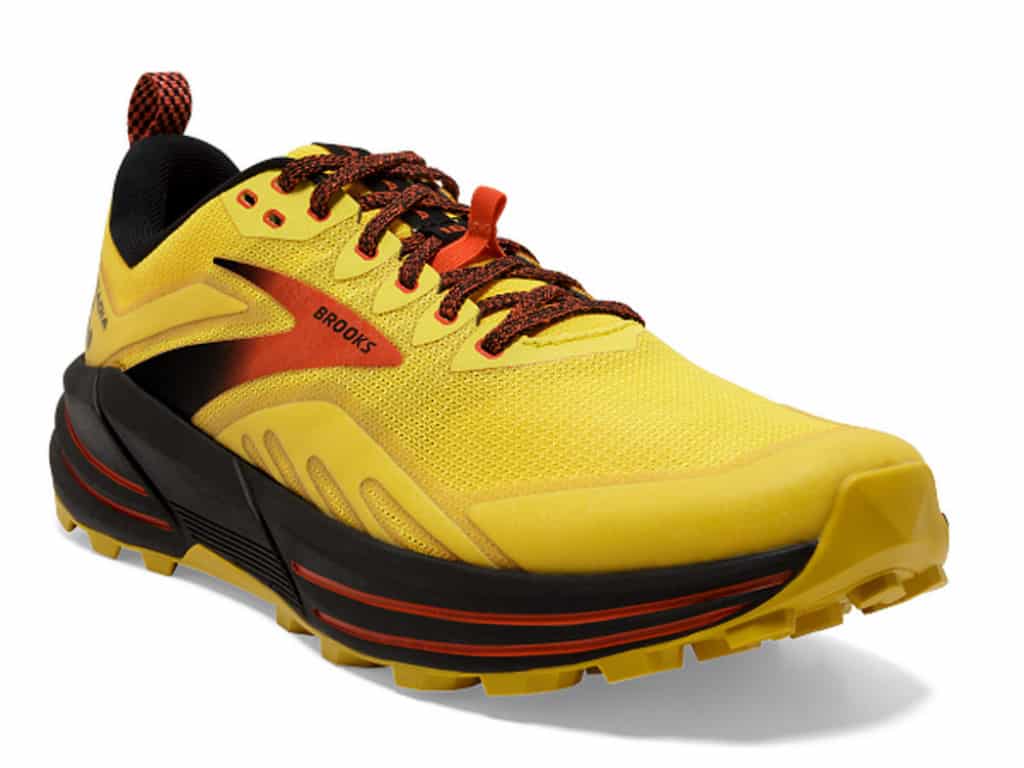
Last update: April 2024
More cushioned without losing ground feel, the Brooks Cascadia 16 is a very good trail running shoe that offers comfort and protection for all conditions.
Discover the latest version released in 2023: Brooks Cascadia 17
Consensus
The Brooks Cascadia 16 is a comfortable and versatile running shoe to run on trails. This new version is lighter (finally under 300 g/10.6 oz) while offering more cushioning (29 mm under the heel).
The upper is softer and more spacious, which makes it more suitable for users with wide feet.
The new Brooks Cascadia 16 is more cushioned and softer at the same time. Also, its outsole offers more flexibility. The result is a smoother and more responsive run. Ah, and the legacy Pivot Post system is finally gone, without any negative impact on stability.
The grip is also top-notch. Even if some reviewers note that the profile of the lugs (medium depth) may not be suitable in some rare cases (really technical terrain, such as mud), not much to complain about here.
Finally, according to users, the value for money is good. These trail shoes feature a high-quality, sturdy build for optimal durability—no signs of wear after 50 miles/80 km—and comes with a reasonable price of $130 (expected retail price).
Read our full review of the Brooks Cascadia 16 for more information.
- Great comfort
- Very good grip for most situations
- Softer, more flexible cushioning that continues to provide a good ground feel
- Durable shoe
- Looser upper for wide feet, without diminishing the lockdown for others
- Still a bit heavy, though finally under 300 g/10.6 oz
- Some reviewers say they could use more grip on very technical terrains
Brooks Cascadia 16 Complete Review Analysis
Introduction
The Brooks Cascadia is the flagship of the American brand’s trail collecting. Of course, it’s impossible to talk about the Cascadia without mentioning Scott Jurek: the legendary athlete has undoubtedly been a critical component of the shoe’s commercial success over the years. For those who do not know Scott Jurek, let’s just say he’s won the Western States 100 seven times (!)! Yup. And, by the way, if you’re looking for a great book on running (with delicious vegan recipes as a bonus), you should read Eat and Run when you have the chance.
However, despite this support, the Cascadia is not the most glamorous trail shoe out there. Also, it’s a model that has changed a lot over the years, with some versions better than others.
After a major overhaul in 2020 with version 15, Brooks is back again with another significant redesign in 2021. We’ll see that it’s for the better with some great reviews and tests from trailers who have extensively tested the shoe.
In a nutshell, here’s what you can expect: softer cushioning, more flexibility, and more toe box room!
Grip (outsole)
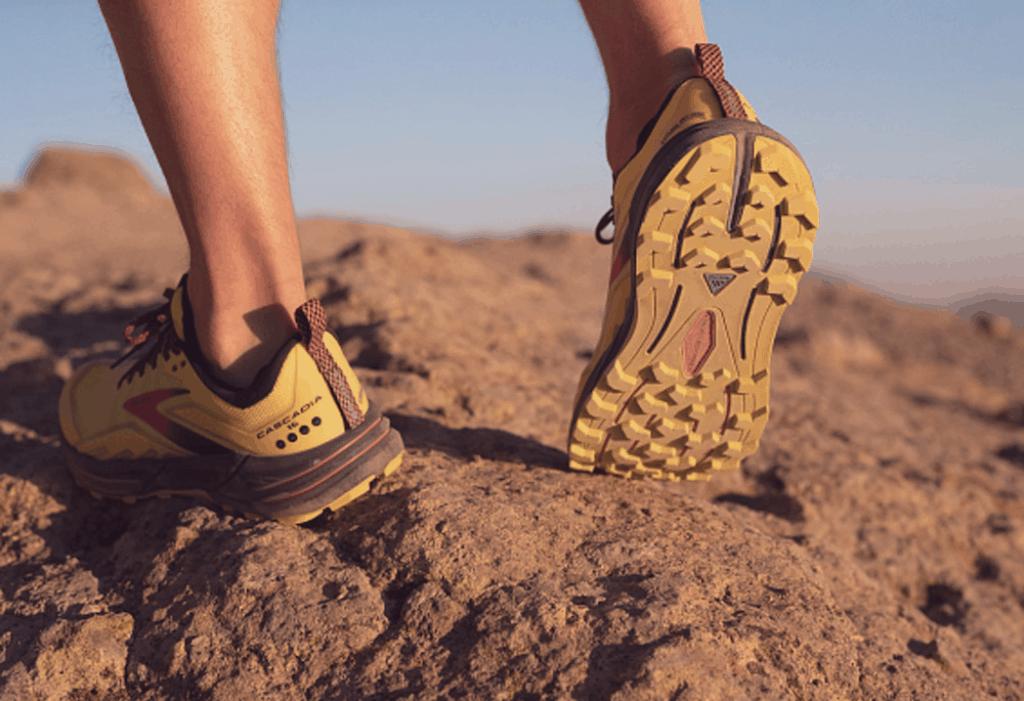
So let’s start with the outsole. It features the good old robust TrailTack rubber technology and its lugs to ensure optimal durability over the miles.
Trail runners didn’t notice any wear even after reaching 80 km/50 miles, which is an excellent sign. It’s undoubtedly one of the strongest suits of Brooks Running. We gently mocked the overall lack of style of their shoes earlier (not on the Cascadia 16, of course, which is quite sleek), but we must give credit where it’s due: it’s one of the best brands out there when it comes to quality and value for money!
Also, the outsole is more flexible, which gives better responsiveness overall. Of course, it makes it easier to find a good balance on tricky rocky terrains.
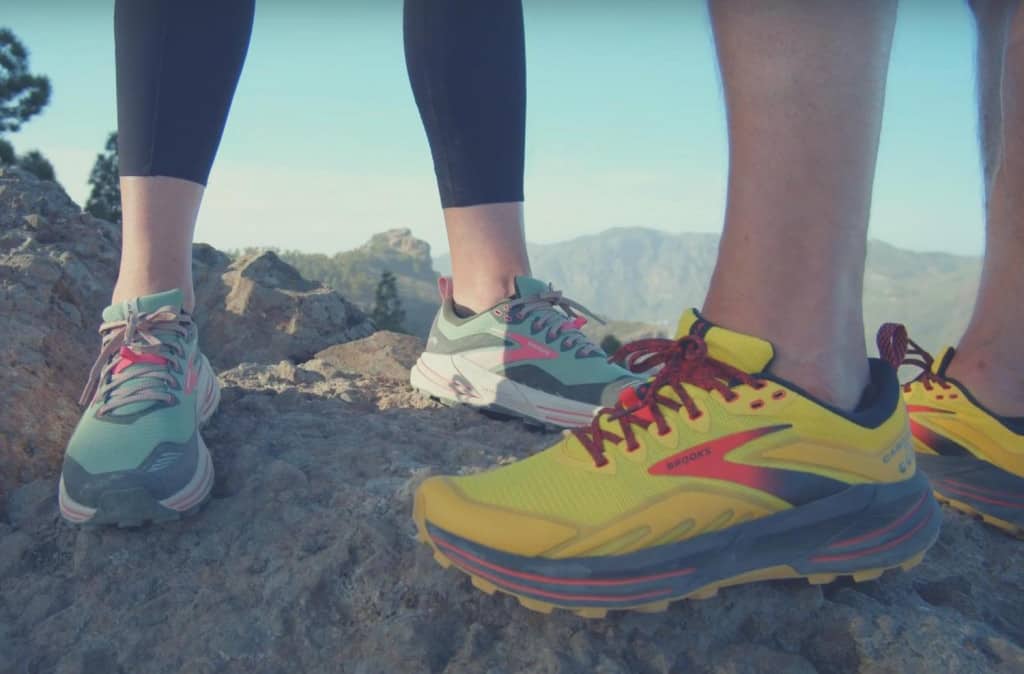
However, to achieve this, Brooks removed the lugs from under the midfoot. In the end, testers didn’t notice it much: there wasn’t a moment when they thought it was missing. So let’s see in the long term how opinions converge. Interestingly, Nike’s Terra Kiger 7 has gone the other way: it now includes lugs under the midfoot, which was not the case in previous versions.
The lugs are medium-sized and arrow-shaped. The grip is very good, and the Brooks Cascadia 16 should be suitable for most situations (e.g., dirt trails, wet surfaces). However, a few dissonant voices among users note that the shoe could do better on very technical courses (imagine slippery mud). So it’s up to you depending on your practice. If you think you’ll only be running on “classic” trails, then there’s no reason to go for a more edgy configuration.
Cushioning (midsole)
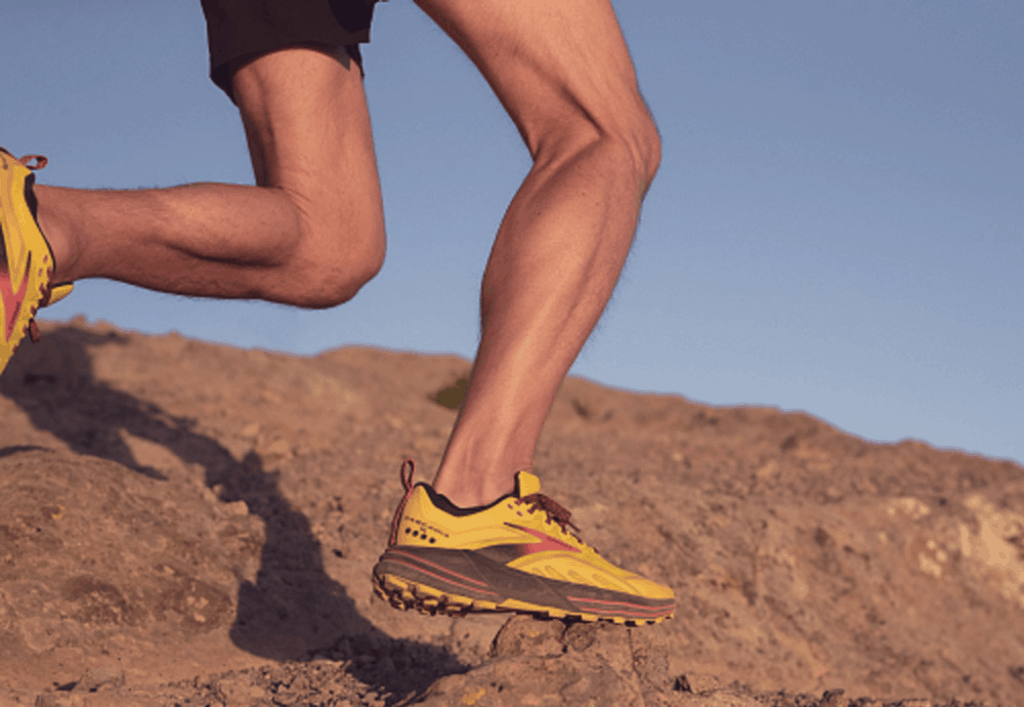
After years of BioMoGO DNA, Brooks is shaking up its collection with new foams that rely on DNA LOFT technology. So, introducing DNA LOFT v2! We spare you the technical details (such as the so-called percentage improvement announced by the brand for the cushion) to focus on how the midsole felt for the testers.
According to them, the cushioning is softer and more flexible than before. It also comes from the extra stack: 29 mm heel height (21 mm under the toes), at least 3 mm more than on the Brooks Cascadia 15. In other words, we are getting closer and closer to the Caldera, the other flagship series in the Brooks trail series, historically more cushioned for long-distance cruising.
The heel-to-toe drop is still 8 mm, which is relatively standard, and a good middle ground for most people.
While the midsole cushioning is softer, testers still note a hint of firmness. Clearly, on a scale of one to ten, with one being very firm and ten very soft, we are on six. The arch support is sufficient to be comfortable during long runs, regardless of your arch type.
We also find the Ballistic Rock Shield: if some find it redundant and heavy, others appreciate the adequate foot protection this built-in rock plate offers.
Finally, note that this model finally gets rid of the infamous Pivot Post System usually reserved for support shoes. Don’t worry, though: testers report that the Brooks Cascadia 16 is stable!
Foot lockdown (upper)
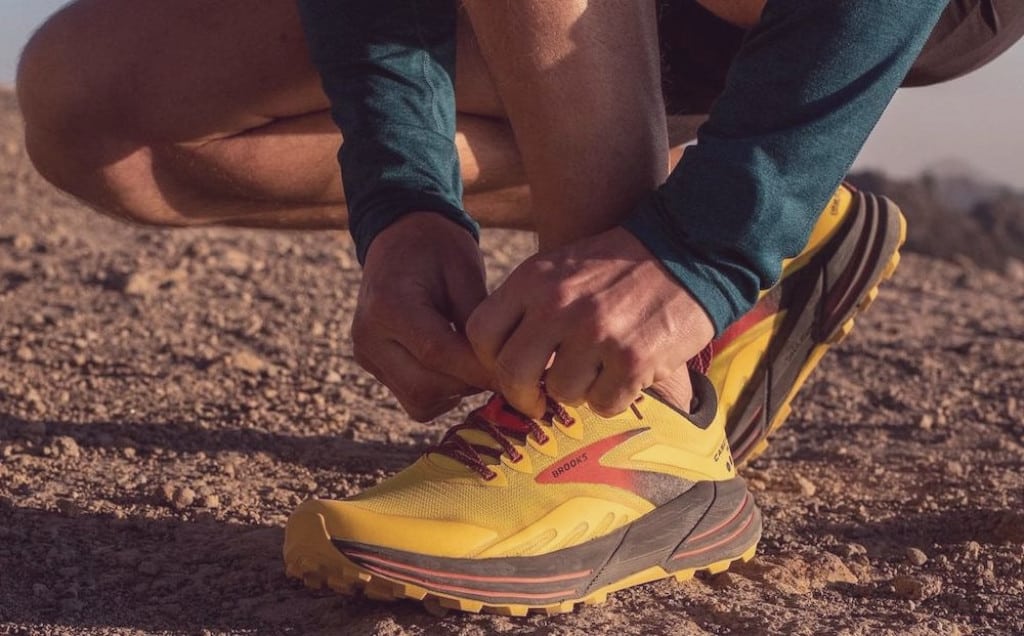
Good news: the upper is roomier on this model to accommodate people with wider feet. Not that the Brooks Cascadia 15 was incredibly narrow, but it’s always better to get more space if you have wide feet, especially if you plan to run long distances. Besides, the looser, more generous fit does not interfere with the upper’s effective lockdown.
The toe box offers optimal protection and is flexible, which contributes to the shoe’s enhanced softness.
The upper uses tightly woven engineered mesh to keep water out. However, it’s also breathable enough. The Brooks Cascadia 16 is available in GTX for more optimal protection from the water, and there’s a velcro attachment point if you plan to use gaiters.
Overall, aside from the increased volume and the thicker heel collar, there are few changes. At the same time, it was not necessary considering the excellent lockdown already provided by the Cascadia 15.
Brooks Cascadia 16’s ride
According to the reviewers who tested the shoe, this new Brooks Cascadia offers the perfect combination of comfort, protection, and bounce.
The increased flexibility coupled with a softer, more generous cushion provides a smooth run on natural terrains.
The weight is not as light as we would expect—298 g (M)/269 g (W)—but runners couldn’t feel it. We still have to appreciate Brooks’ efforts to increase the cushioning and sole height while shaving a bit of the weight simultaneously (7 g less, yay!).
Last but not least, if the Brooks Cascadia 16 received such high scores from the testers, it’s also because of the excellent ground feel it offers. Typically, you have to choose between cushion and proprioception. Well, not here!
Conclusion
The Brooks Cascadia 16 ticks all the boxes: comfort, protection, cushioning, traction, and responsiveness. All testers gave it a very high rating, making the Cascadia a strong contender for the best trail running shoes 2021.
Facts
Technical Specs
| Terrain | Trail |
| Pronation type | Neutral |
| Drop | 8 mm |
| Heel stack height | 29 mm |
| Forefoot stack height | 21 mm |
| Weight (men) | 298 g/10.5 oz |
| Weight (women) | 269 g/9.5 oz |
| Features | Available in GTX, Gaiter attachment point, Rock plate, Toe cap, Vegan |
| Fit | Wide feet |
| Athlete | Scott Jurek |
| Release year | 2021 |
Cushioning
| Softness (1-5) | 3 – Moderate |
| Bounce (1-5) | 4 – Soft |
Technologies
| Outsole | Ballistic Rock Shield, DNA Loft v2 |
| Midsole | TrailTack |
| Upper | Engineered Mesh |
Use
| Speed | Mid distance, Ultramarathon, Long distance |
| Distance | All |
| Workout | Daily running |
Comparisons – Brooks Cascadia 16 vs.:
Brooks Cascadia 15
More cushioned, softer, roomier! All without sacrificing ground feel or foot lockdown. Therefore, the Brooks Cascadia 16 is more accessible and should suit more trail runners than in the past. Definitely an upgrade!
Brooks Caldera 5
See the side-by-side comparison with our analysis.
Hoka Speedgoat 4
See the side-by-side comparison with our analysis.
Saucony Peregrine 11
See the side-by-side comparison with our analysis.
Brooks Catamount
See the side-by-side comparison with our analysis.
Frequently Asked Questions (FAQs)
This shoe follows a standard sizing system. Testers confirm that it fits true to size. So you can choose your usual size.
Yes, there are two versions available: standard and GTX.
It’s not its main function, but yes, it’s possible. In terms of traction, it’s on par with hiking boots. However, the low-cut design can limit ankle support, especially if you are carrying a heavy backpack.

Cascadia models 14-16 are crap compared to the models Cascadia 13 and earlier. The new models have a terrible trail grip, you can feel every little stone because they removed the harder soles, they are now wider for some stupid reason, they are like running in flip flops. For years I bought these shoes and loved them, threw the new model in the trash because they are the worst shoes I have ever purchased.
Hi Kevin,
Great review, thank you.
The wider fit seems promising.
I was wondering: did you test the medium (1D) or wide (2E) model?
Hi there, glad you liked our analysis! Please note that it’s a mix of our personal experience and what we have read from other reviews. It applies to the medium (1D) version. Cheers, Kevin
I think where these Cascadias excel is as a Trail Runner. People who complain that they arent good on rocks etc. I’ve read all the reviews on the internet.
Wear a hiking boot if you are climbing rocks
These provide adequate protection for the average person and thats how Brooks markets them.
I use mine on fire roads, railroad tracks, light trails & hills. They work really well at that. I would hike mountains in them if it was all I had and I’m sure they would be capable of that. ….but (I prefer a hiking boot for that activity). The Gore tex version of the cascadia 16 is my go -to winter running shoe, good grip on icy roads and my feet stay warm and dry. I really like the DNA loft 2 cushioning. It makes the shoe feel responsive. My New Balance Hierro V6 fresh foams feel too spongy on the trails. Different shoes for different terrain and purposes. Its nice to have choices. I will still give the Cascadia 16’s 5 stars overall for an affordable, rugged, capable, package.